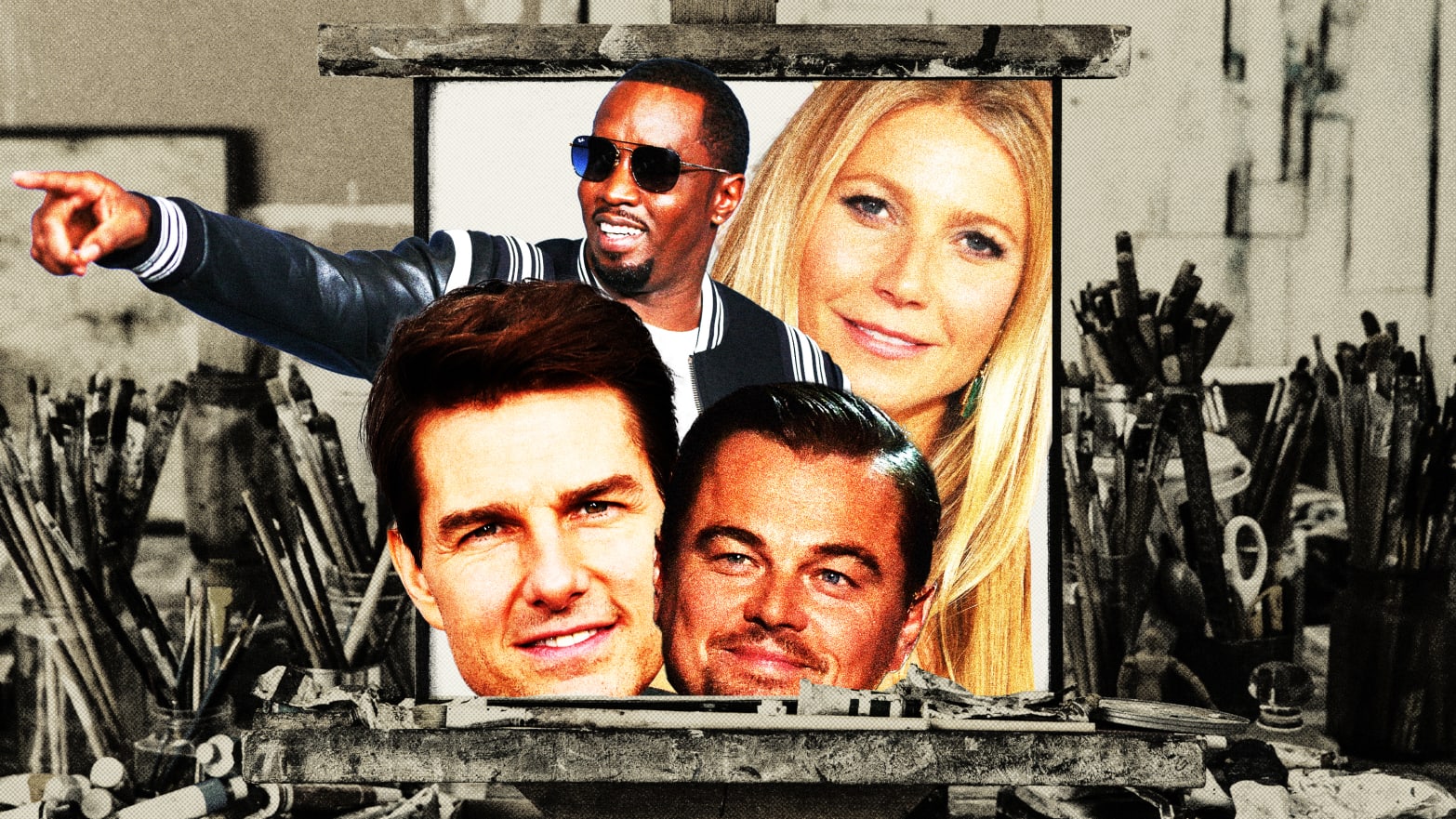Inside the Secret, Very Expensive World of Hollywood’s Star Art Collectors
Movie stars collect art because they want to match their peers. As one adviser says, “Belonging to a club is a huge motivation for people: ‘If he has it, then I should have it.’”

Photo Illustration by Elizabeth Brockway/The Daily Beast/Getty
In the 30-odd years Barbara Guggenheim has worked as Tom Cruise’s art adviser, a theme has been established: “He collects works that are very intense, that have a lot of movement and that are very positive, and I think that that’s who he is,” Guggenheim told The Daily Beast.
No kidding—over a career spanning decades, Cruise has solidified his reputation as one of the hardest-working, hardest-driving actors in the blockbuster business; a relentless force of nature who propelled Top Gun: Maverick, the juggernaut sequel to the ’80s classic, to box office Valhalla this year and who also once jumped for joy on Oprah’s couch.
Very little is known about Cruise’s art trove. Guggenheim, invoking her role as a fiduciary, declined to answer specific questions about the size and contents of the actor’s collection. Undeniably, though, for celebrities of Cruise’s caliber, even the reported existence of a robust yet mysterious art collection can communicate creative dexterity in a way few other material things can.
Amongst the ultra-A List, there are several luminaries known to possess incredible collections. Leonardo DiCaprio, named after da Vinci by his artist parents, is a prolific treasure accumulator with a personal collection estimated to be worth $10 million that includes work by Takashi Murakami, Frank Stella and Ed Ruscha; he’s also been known to appear at auctions at Christie’s and Sotheby’s.
Record and studio executive David Geffen’s art collection is estimated to be worth a staggering third of his personal net worth. The collection, which at one point included work by Pollock and de Kooning, is reportedly worth $2.3 billion.
“When I started, a lot of people in LA, like Steven Spielberg and George Lucas, collected social realism because they viewed themselves as being socially responsible storytellers,” Guggenheim said.
Spielberg and Lucas, whose collections are estimated to be worth $240 million and $600 million, respectively, both own multiple works by the iconically sentimental American illustrator Norman Rockwell.
An impressive, diversified cache of art isn’t something that just comes together overnight.
“Some people think, ‘I’m a 25 year old actress and made a boatload of money, and I can just go buy whatever I want,’ and that’s actually not true,” Burns said. “You might be offered the lesser work, because the dealers don’t take you seriously. You can’t just buy a collection: you build a collection. If I’m working with someone who’s definitively serious—they’re doing some of the reading and research with me, they’re not just decorating their house—that’s when the dealers open the door and offer the best material. If you’re Alicia Keys or Swizz Beatz or Beyoncé, I mean, those guys can just walk in the door,” Burns said.
No such problem exists for Cruise, who’s proven over time that he’s an active and educated participant in the art world. “I’ve known him such a long time, and his collection has taken a trajectory from more established, traditional artists to more contemporary classics,” Guggenheim said.
But for the ultra-famous, other barriers exist. “Certainly I’ve been to galleries and auctions with Tom, but you have to do it after hours,” Guggenheim said. “I can remember one day we got out of a gallery and literally, it was like 10 steps to the car, and maybe 300 people surrounded him.”
Most celebrity clients are too busy to visit auctions, galleries and fairs personally, advisor-to-the-stars Maria Brito (clients include Sean “Diddy” Combs and Gwyneth Paltrow) told The Daily Beast. “The art world is just way too big right now for anybody to keep up with it, unless you are 100% dedicated to that,” Brito said.
Every day, Brito assesses the between 10 and 30 proposals from galleries looking to place work with her clients that fill her inbox. She determines whether or not to show the work to her clients based on her knowledge of what they potentially could get excited about, she told The Daily Beast.
Brito works with hardcore collectors who buy works of art every week, and who are constantly on the hunt for something fresh. “Celebrity clients don’t really buy with this frequency,” Brito said, adding that celebrity collectors’ motivations for collecting differ from those driving year-round auction obsessives.
“People may have seen something at someone’s house and fallen in love with an artist, or heard a story from the owner of that house about how this is the coolest artist,” Brito said. “Belonging to a club is a huge motivation for people: ‘If he has it, then I should have it.’ The truth is, finding someone who’s a very independent thinker in the world of Hollywood is just hard.”
What’s more, all celebrity art collections are certainly not created equal.
“With every client, I try figure out what their ambition is around collecting,” Victoria Burns, a Los Angeles-based art consultant and adviser, told The Daily Beast. “Are they collecting art for social purposes and image expansion? Are they trying to create a certain image of themselves and their personal brand through the art that they collect? Or are they really emotional people who have to really connect with the art?”
“I spoke with a guy in the music industry, and he was about to sell his first big song,” Burns said. “He wanted to collect art, and yet he’s young, so he said he wanted to collect from his own generation. He didn’t want Andy Warhol on his wall, because he’s 35 years old.”
“The celebrity clients that I deal with have a real love of art,” Jackie Wachter, a senior specialist in private sales at Sotheby’s LA, told The Daily Beast. “There are Black clients I work with who are very focused on building collections of artists of color.”
“People also see things on their friends’ walls,” Wachter said, adding that most of her clients are in their forties or fifties. “I sold a Beauford Delaney piece recently to a celebrity client who had seen it on a friend’s wall.”
As more and more celebrities are getting interested in collecting, LA galleries, like Various Small Fires, Sprüth Magers and M+B can barely meet the demand: “Some of the young, hot galleries right now in LA, they’re selling out shows two weeks before they open,” Burns said. “They literally make six phone calls and everything’s sold.”
“People get the bug”
During the halcyon days of mid-20th century Hollywood, celebrity art collectors were rare because American art collecting itself was incredibly rarified. In the aftermath of the Industrial Revolution, barons like J.P. Morgan and Henry Clay Frick fell over each other to amass the most intimidating strongholds of Old Masters, but celebrity art collectors only really began to pop out of the woodwork en masse more recently.
There were innovators: Edward G. Robinson, a Romanian-American actor famous for playing hardened thug roles at the height of Hollywood’s Golden Age, was a prolific collector in his private life: Robinson enthusiastically snapped up African sculptures, early works by Reuven Rubin and Frida Kahlo and Post-Impressionist masterpieces.
“Here is a paradox: Turn killer and you have the means to satisfy your thirst for beauty,” Robinson wrote, movingly, when the Museum of Modern Art staged an exhibition drawn from his collection in 1953. “When Hollywood conveyed me, through devious and sin-stained roles, to a succession of sizzling electric chairs, the paintings began to appear.”
“In Hollywood, art is the scene,” Barbara Isenberg explained in the LA Times in 1991. By this time, heavyweights like Barbra Streisand and Jack Nicholson had collections well underway. Nicholson, who, like Streisand, began collecting in the ’60s, owns work by Modigliani, Magritte, and Warhol, and artist Ed Ruscha called the actor’s $150 million collection “one of the best out here.” The enmeshment makes sense: cinema is an art, so why wouldn’t participants in the creation of moving images also be moved by images?
In LA, major outposts of Christie’s and Sotheby’s (Phillips Los Angeles opens October 2022), as well as of major galleries, are prepared to meet the demands associated with the city’s solidifying identity as an arts hub.
“It feels like LA is becoming much more of a center than it was, which is really exciting,” Wachter said. “I think Hauser & Wirth is doing a great job. They really are a presence in Los Angeles, and so is David Kordansky.”
Long-established, “definitively serious” Hollywood collectors also include Steve Martin, who’s channeled his passion for Indigenous Australian art into exhibitions with Gagosian Gallery; the late Gianni Versace, whose personal collection included Matisse and Degas; and Madonna, who began collecting in 1987 and who’s amassed a collection worth a reported $100 million.
In tandem with the explosion of Instagram and the birth of ever-younger tastemakers, influencer-magnates like the Kardashians are birthing a new breed of collector: the heavily-filtered, contemporary art-hungry maven.
Ironically, at least three of the impeccably coigfed Kardashians own work by Tracey Emin, the shock-and-awe U.K. radical whose 1996 “My Bed” installation blew the art world apart with its distinctly feminine squalor. Kim favors minimalist work by Isabel Rower, while Khloé opts for Patrick Demarchelier prints.
“Collecting is a visual journey, an emotional journey, an intellectual journey and a market journey,” Abigail Asher, Guggenheim’s partner at Guggenheim, Asher, Associates Inc. art advisory firm, told The Daily Beast. “There are many different factors and considerations that go into collecting, and the goal is that the collector is satisfied in all of those aspects.”
“I find that a lot of my collectors gain momentum as they go,” Wachter said. “They get more and more excited, more and more involved. They want to attend more events and go to more and more artist studios. People get the bug. Celebrities are just like us in that way.”


No comments:
Post a Comment